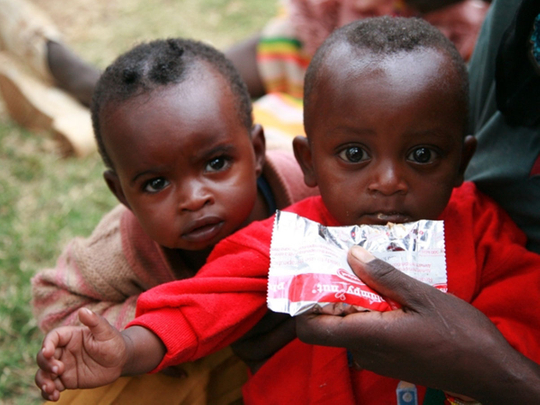
There’s some potentially great news about food — especially for people who have very little to eat. It’s a new strategy that could save the lives of hundreds of thousands of hungry children every year.
Fifty million children under five years suffer from acute malnutrition. It’s one of the biggest contributors to the nearly one million deaths each year of children under five. Malnutrition wears down the immune system, so a child can die from a cold. It also can cause permanent physical and cognitive damage to children who survive.
Acute malnutrition is easy to treat with therapeutic food. The best-known of these is Plumpy’Nut, a packet of peanut butter, dried milk, oil and sugar fortified with extra vitamins and calories introduced in 1996. It’s very effective for children who get it; one or two packets a day can restore a child to health in a few months. But most children don’t get it. “At best, we are providing treatment for 20 per cent of children with severe malnutrition,” said Victor Aguayo, chief of Unicef’s global nutrition programme.
Why do we fail children so badly? One reason is we aren’t willing to spend the money. Voluntary donations from governments finance the United Nations’ food programmes. The World Food Programme is frequently forced to cut food rations and turn people away. Right now, severe child malnutrition in Africa’s Sahel countries is the highest in a decade, but Unicef has only 35 per cent of the funds it needs to treat children.
Hunger is rising again after declining for many years. One major cause is climate variability and extremes. The Sahel crisis is due primarily to drought.
But another factor is war. It’s especially hard to work in those war and chaos zones where malnutrition is common. Today, the most severely malnourished places are Yemen and South Sudan — both entirely man-made crises. The disruption of war means families can’t work, can’t reach crops and livestock or bring them to market. Health and sanitation systems shut down and workers flee.
But there’s a third reason so many children don’t get help — really bad design. The World Food Programme and Unicef share responsibility for feeding children. “There are two protocols, two institutions, two delivery mechanisms, for one group of children,” said David Miliband, the head of the International Rescue Committee. “It doesn’t make any sense at all.”
And the system requires desperate mothers to come to the food every week — which can mean walking for miles through perilous terrain, and then waiting for hours — rather than getting the food to them.
The way we save hungry children needs an efficiency overhaul.
Now it may have one. A group of organisations that feed children, including the IRC, Action Against Hunger and the Alliance for International Medical Action, have worked in several countries to test a new system that eliminates the duplication. So far, it works. One reason for success is its simplicity; community health workers can diagnose problems and treat children at home very successfully.
Here’s how malnourished children have been treated until now: If the child has a complication, such as pneumonia or fever, he or she goes to the hospital. Uncomplicated cases are separated into two categories, severe or moderate.
Unicef treats severe cases, usually giving children Plumpy’Nut packets to take home. The child must come back every week for a check-up and more packets. Children with moderate malnutrition go to a World Food Programme feeding centre, where they can get food on site and take-home food, often a corn-soy blend, to supplement the family diet.
What could possibly go wrong? A large majority of malnourished children can’t reach either programme. “Mothers have to walk for hours, and even if they get there, the service might not be available,” said Mesfin Teklu Tessema, senior director of health for the IRC.
When programmes do exist, a mother has no idea which one to go to. “The referral between programmes doesn’t always work,” Landis said. And it’s hard to make a weekly trip.
Since money is short, it is focused on treating severe cases. That means many children get no treatment for malnutrition until they deteriorate to the point where it is severe. This endangers children and creates extra costs, because they might need hospitalisation. It also leads to a lot of relapses, because children can, in effect, be cut off treatment once they are only moderately malnourished.
Even this flawed system, though, is far better than what came before, when hospitalisation was the only treatment for severe malnutrition. In the past decade or so, the number of children treated each year has more than tripled. Much of the increase can be attributed to Plumpy’Nut. With Plumpy’Nut, or other similar high-nutrition blends developed since it emerged, a parent can easily treat a child at home. There’s nothing to measure or prepare, and it doesn’t have to be mixed with water, which is often unsafe to drink.
The other factor is the growing numbers of community health workers. But they are still not widespread in every country, and few of them deal with malnutrition — in part because the system is so complex.
A single, simplified protocol would enable a child to be treated wherever a mother brought him or her. The programme becomes easier to manage and can cover more children. And if it’s simple enough for community health workers to use, they can find many more children, catch malnutrition earlier and reduce missed doses.
— New York Times News Service
Tina Rosenberg won a Pulitzer Prize for her book The Haunted Land: Facing Europe’s Ghosts After Communism. She is a former editorial writer for the Times.








